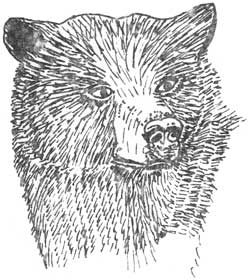IZZ THERE A GRIZZ???

No not really, but therein lies an interesting story! About
mid-summer, 1986, we received a report from visitors who had been hiking
on the east side of the park. They had just returned from a trip to
Yellowstone National Park, and there had been educated about grizzly
bears. While hiking near Dewey Lake, on the Cascade Crest, they had
seen, at a distance, a large, brown bear. It was not only large and
brown, but appeared to have a hump over the shoulders, and also a
lighter cape of long fur on the shoulders as well. One or two days
later, Randy and Ann Brooks were hiking in the same general area, and
also saw a larger, brown bear. Randy said that it was too far away to
tell anything else, but it did appear to be big.
A call to the U.S. Forest Service yielded the information that there
had been reports of a large, brown bear in the William O. Douglas
Wilderness Area about 2 or 3 years ago. I then called a friend in the
Washington Department of Game.
He didn't know of any reports of grizzly bears, but did add that the
grizzlies that had been definitely identified in Washington State tended
to be smaller than in some other areas, and that this might be one.
The Mount Rainier Elk Chasers were dispatched to the area with
instructions to look for a large, brown bear while they were looking for
elk. John Scott and Roger Christophersen spent two days in the area, but
encountered no bears at all.
A couple of weeks later, the park received a letter from a professor
from the University of Washington. He had been hiking in the Dewey Lake
area with several friends, and had also seen a large, brown bear. He and
his companions were familiar with bears, and felt that this one had a
shoulder hump and the bleached fur that are common to grizzlies. They
were not able to get close enough for any photos, or positive
identification, but they sure were curious about the critter.
Dave Uberuaga, the Park's Administrative Officer, happened to stop in
on a Friday evening to say that he was taking his family for a hike to
Dewey Lake the following day. He asked if there was anything that he
should be on the lookout for. I said sure, look for a grizzly. Dave was
first incredulous, then a bit concerned for the safety of his children,
but he agreed to watch for bears.
On Saturday evening, Dave stopped in at the office to tell me that
they had gone hiking to Dewey Lake as planned, and had indeed seen a
big, brown bear. He had a camera with him, and had been able to get
within 70 feet of the bear, and had taken its portrait. The film was
promptly sent to be developed and printed. We anxiously awaited the
pictures. When they came, sure enough there were several pictures of the
big, brown bear. It certainly was big, brown, and a bear. However, it
was just as certainly a brown phase of the American Black Bear.
End of mystery...End of story!
Stan Schlegel
from Origin of Geographic Names of Tacoma/Pierce County
Washington by Gary Fuller Reese
CHRISTINE FALLS -- on the lower part of Van Trump Creek, formed where
this creek approaches the main level of Nisqually Canyon. The falls were
named by John Hayes of Yelm for Christine Louise Van Trump, daughter of
P.B. Van Trump.
COLUMBIA CREST -- The name was suggested by H.E. Holmes of the
Ingraham party in 1891. They had spent two nights in the crater and
before leaving voted on a name for the highest part of the summit [of
Mount Rainier], with Columbia Crest as the result. It has occasionally
been called The Dome. By Stevens and Van Trump it was called Crater
Peak, Elevation, 14,410 feet above sea level.
EMMONS GLACIER -- On the northeastern slope of Mount Rainier, this is
the largest glacier on the mountain. For a long time it was called White
Glacier because it gave rise to the river of that name. The river's
name came from the glacial whiteness of its waters. The present name is
in honor of S.F. Emmons, who with A.D. Wilson, made the second
successful ascent of the mountain in 1870.
WINTHROP GLACIER -- lies on the northern slope of the mountain, where
it head joins that of Emmons Glacier. It is named in honor of Theodore
Winthrop, who passed close by the mountain in 1853 and recorded his
observations in his book entitled "The Canoe and the Saddle."

